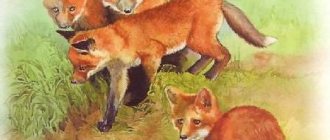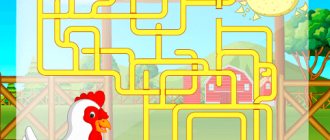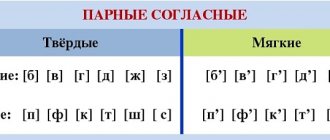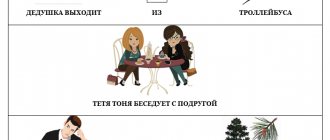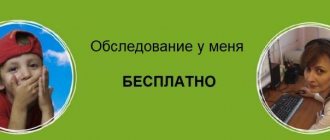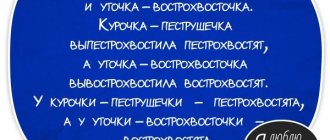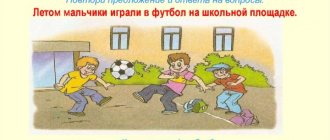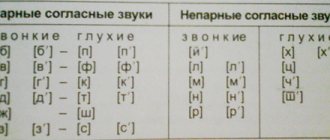Purpose of the lesson: we study the letter E, the formation of reading skills, the development of speech skills, the improvement of phonemic awareness, the basics of elementary graphic skills.
Tasks:
- introduce the preschooler to the letter E and the correct pronunciation of the sound;
- teach how to write the printed letter E in squares;
- to generate interest in learning poems and riddles.
Name what is shown in the pictures below:
Electricity
Escalator
Excavator
Eclair
When we pronounce the sound [E], air comes out of the mouth freely. Say: EEE. Neither lips, nor teeth, nor tongue prevent air from freely leaving the mouth when we pronounce the sound [E].
- Tell me, what is an echo?
- Listen to the sentence: EMMA AND ELLA LISTENED TO THE ECHO.
- ECHO - what is the first sound in this word?
- What is the first sound in the word ELLA? - EMMA?
- What sound is there in both the word EXCAVATOR and the word ESCALATOR?
- Is the [E] sound in the word ESCALATOR at the beginning, at the end or in the middle of a word? - EXCAVATOR? MAYOR?
- Vowel or consonant sound [E]?
Introducing the letter
Card with the letter E.
Study E: show the children a card with the letter, pronounce it. Offer to draw the outline of E in the air, lay it out from beans or pieces of rope. Describe the sound: say that it is a vowel, you can sing it. When pronouncing a sound correctly, the mouth is slightly open, the lips are stretched, and the tongue is not used. The stream of air comes out freely, along the tongue, no one sees it.
The articulation is similar to the sound I, although the stream of air coming out of the mouth is an order of magnitude stronger. The production of the sound E in children of the senior group of kindergarten occurs by imitation. The teacher suggests repeating the sound out loud separately and in structural syllables. You can show pictures or objects whose names have a common letter, while pronouncing the words out loud, focusing on the sound E.
Literacy lesson (reading) for inclusive 1st grade on the topic: Vowel sound [e]. Letters E, e.
4.Learning new material.
Development of the speech apparatus. Articulation:
To pronounce the sound [e], we open our mouth, the tongue is at the bottom and slightly raised. (Teacher demonstration).
Repeat.
Look at the picture (slide from the film Puzzle)
Who knows the characters? Name them. How to call it in one word? ( E
emotions). Name the first sound.
Breathing exercises.
Emotional correction
. Say the sound [e] in a low voice, draw it out, expressing joy,...sadness, anger, fear, disgust.
Introducing the sound
[e] .
Let's say it again and characterize the sound, what kind of vowel or consonant is it? Why? In what color scheme?
Guess the riddle (electronic appendix by V.G. Goretsky and others): 1.
You shouted - it was silent.
You were silent - it screamed .
What is Echo? Let's play echo? (ABC p. 59) The teacher begins to read the text, the children name the end of the word.
We need to make a diagram for the word ECHO.
We will work in pairs. Take an envelope to create a sound model of a word. The student of option 1 lays out a diagram, option 2 - in the role of a teacher, checks and evaluates the work of his partner...
We check the work at the board. How many syllables, where does the stress fall? Where is the sound in a word? Compare your work with the tested work on the board. Rate your work with a smiley (green – I’m happy, everything worked out, yellow – it worked, but it was difficult, red – it’s difficult, I need help)
2
.
There is a large canvas on the wall in the cinema.
Adults and children come here to watch movies.
(Screen)
Make a diagram for the word. The student of option 2 lays out a diagram, option 1 - in the role of a teacher, checks, evaluates the work of his partner...
We check the work at the board. How many syllables, where does the stress fall? Where is the sound in a word? (at the beginning of the word). Check it out. Rate it - smiley.
Draw a conclusion:
What did you learn about the new sound while working as a pair? (formulate together, teacher corrects). Repeat the conclusion to each other in pairs.
3.
What is the name of the main person of the country?
(Slide with a portrait of the president) And who is in charge in the city (mayor)
? (Photo on the slide). Where is the sound in this word? (in the middle of a word, after a consonant)
How to pronounce the consonant before the letter E, hard or soft? Make a diagram of the word MER. Agree on who posts and who checks. Check (slide). Rate it with a smiley face.
Draw a conclusion:
what else have you learned about sound? (formulate together, teacher corrects)
Repeat the conclusion to each other (in pairs).
What do you remember about the sound [e]?
Physical exercise (motor) -
game "Find the sound [e]".
Stand up. Stretch. Give yourself a hug.
I will name the words. If they have the sound [e] - raise your hands up; if there is no sound - squat down. Try to remember as many words as possible with the letter E....
What words do you remember? What do they mean?
Have we achieved our first goal? What's the next goal?
Automation of sound E
The next stage in learning the letter and sound E is automation. The teacher can attach pictures to the board and invite preschoolers to name objects. For example, escalator, excavator, emu, screen, electricity, etc.
In the process of teaching children, it is important to use play methods, for example, a general game with a ball. The teacher throws the ball to the child and says the word. The preschooler must catch the ball if he hears the sound being studied. Memorization is better when reading entertaining poems, riddles and fairy tales. In addition to visual and auditory training, the child should also be given written tasks.
What does the letter e look like? children's drawings. "Entertaining ABC"
Purpose of the lesson: we study the letter E, the formation of reading skills, the development of speech skills, the improvement of phonemic awareness, the basics of elementary graphic skills.
- introduce the preschooler to the letter E and the correct pronunciation of the sound;
- teach how to write the printed letter E in squares;
- to generate interest in learning poems and riddles.
Name what is shown in the pictures below:
Electricity Escalator Excavator Eclair
When we pronounce the sound [E], air comes out of the mouth freely. Say: EEE. Neither lips, nor teeth, nor tongue prevent air from freely leaving the mouth when we pronounce the sound [E].
- Tell me, what is an echo?
- Listen to the sentence: EMMA AND ELLA LISTENED TO THE ECHO.
- ECHO - what is the first sound in this word?
- What is the first sound in the word ELLA? - EMMA?
- What sound is there in both the word EXCAVATOR and the word ESCALATOR?
- Is the [E] sound in the word ESCALATOR at the beginning, at the end or in the middle of a word? - EXCAVATOR? MAYOR?
- Vowel or consonant sound [E]?
Look at the letter E. Write it in the air, and now in your notebook, carefully in the cells with a simple pencil or ballpoint pen.
In cases where the child is asked to write a whole line of a letter, syllable or word, the adult gives a writing sample at the beginning of the line.
If a preschooler has difficulties, then an adult can draw two approximate lines, or put reference points that the child will connect with lines, or write the entire letters, and the child will simply circle them in a different color. Calligraphy should not be required at this stage of training.
Task for preschoolers: printed letter E
To increase the effectiveness of learning, it is necessary to give the child in the preparatory group written assignments or online assignments:
- circle by dots;
- add a letter;
- find E in the picture;
- cross out incorrectly written letters;
- color objects that contain E, etc.
We write the letter E.
History of the letter E
The sign E is present in the South Slavic Cyrillic alphabet as an allograph of the letter E, used in the 13th and 14th centuries.
In earlier times, it was only a leader above the line (around 1284, paleographer E.F. Karsky).
Old Russian writing suggested this sign to be similar to the letter Z. The letter first appeared in the late 14th and early 15th centuries.
They suspect that it was copied from the Glagolitic antigraph.
The letter came into the Western Russian alphabet at the end of the 15th century and then began to be included in alphabets throughout Muscovite Rus'.
It later appeared in the Poznań manuscript at the end of the 16th century. E began to be written in words such as: tsEsar, knightEr, etc.
The letter E became an official character in the alphabet only in 1708, when the civil font was created.
Tales about the letter E
On our planet there is a mysterious country called ABC. Different residents live there, and each has its own name. Somewhere on the very edge of the ABC lives the letter E. Other letters rarely visit it, because it has settled in a tall building, on the 31st floor.
E loves to go out on the balcony and look at the large eucalyptus tree growing right next to her house. On this eucalyptus tree lived little elves who worked day and night. They worked in a factory where they made the most delicious popsicle in the world. E loved to watch the little people work and often gave hints and help to them. As soon as the head elf shouted “Hey-hey,” a long, ringing echo was heard. This meant that the next portion of ice cream was ready. Then E would go down the escalator to eat her favorite treat.
There was a station near the eucalyptus tree, to which a train arrived every day. On weekdays, E worked on an excavator, digging holes in which the elves built new premises for their factory. And on Sunday E rode the train along ABC and ate a chocolate popsicle.
Letter E in Russian writing
The strange letter “e” reached the Russian alphabet, and more precisely, the Russian written language, in the form of an unioted vowel through words such as: this, edakiy, eh, ege-ge, etc.
It began to be used at the beginning of a word and after vowels: echo, floor, poet, duel, etc. I can't even think of words with this letter. If you can add your own to this series, I will be glad to read them in the comments.
It’s just that after E and I it is customary to write E, not E. There are, of course, exceptions: Marietta, Gliere, etc.
The pure sound of E is only in words of foreign origin, in native Russian ones - only E: go, eat, etc.
Therefore, E is called specific for borrowed and foreign words.
Russian critics called E a “strange letter,” and Belinsky was completely against the shape of the letter.
A.P. Sumarokov spoke insultingly about E, calling this letter “a freak of the Russian alphabet.” Although if you look closely at her, I don’t see anything ugly in her. Well, she looks in the wrong direction as the other letters of the alphabet. So what. In any family there is not without... the letter E.
It was interesting to see the opinion of Groth, who was against the use of E after consonants, but defended his opinion regarding the placement of the letter at the beginning of words and after vowels.
Suitable Games
Didactic games for attentiveness:
- Find the same sound in the words (screen, emu, equator, relay).
- Think of a word starting with E.
- Clap your hands as soon as you hear a word with the desired sound (watermelon, polymath, monkey, eureka, echelon, turkey).
- Find the extra word in the series. (standard, eucalyptus, ear, excursion).
- Game “Complete the word” (learning the structure of words) Eta (floor), bale (crew), sport (export), coupon (standard), press (express), strada (stage), floor (Hermitage), crane (screen).
- Game "What's missing?" Objects (toys) are laid out on the table, the names of which contain the letter being studied. The child is asked to name all the objects, and then turn away or close his eyes. At this time, the teacher removes one item, and the child must name what is missing.
Game exercises:
- Speech exercises. Repeat the syllables EP-OP-AP, AP-EP-IP, OP-EP-UP, EP-OP-EP, IP-AP-EP, UP-OP-EP.
- Master class “Houses”. Prepare houses with three windows (diagram: beginning, middle, end of the word) and suitable subject pictures. The child needs to determine the location of a given sound in a word and insert a picture into the first, second or third window.
- A funny group. For this game you will need a table with printed letters and chips (coins). Children need to find E in the tables and cover them with chips.
- Letter constructor. Invite the children to complete the E from other letters (O, C). You can use beans or other grains.
- Telephone competitions. Children sit in a row. The teacher speaks the tongue twister into the ear of the first child, and he passes on what he heard to the next. The last player must recite the tongue twister out loud.
There are many didactic games and exercises that will help turn the learning process of preschoolers into an entertaining and exciting activity.
Letter E after consonants
Consonants are rarely written followed by an E. Back in 1956, rules were introduced that E is allowed only in the words: mayor, peer, sir and proper names.
These rules were amended in 2006. Then E was included in three more words after consonants: plein air, racket, rap.
There are also some words with E after consonants, for example: hash/hash, tag/tag, cab/cab. But they look more like purely foreign.
The names of letters are also written with E: be, ve, ge, etc.
The use of E as an interjection will also not surprise anyone: E! Come here!
One single letter, and how much power it has when shouting at someone.
This strange letter E. You are not Be or Me, or even Ge. You have a very strange appearance, But you came to our alphabet. How much did you have to endure? Only in the last row was there a place for you.
That's the whole story about the letter E. Until new interesting meetings on my website, friends!
